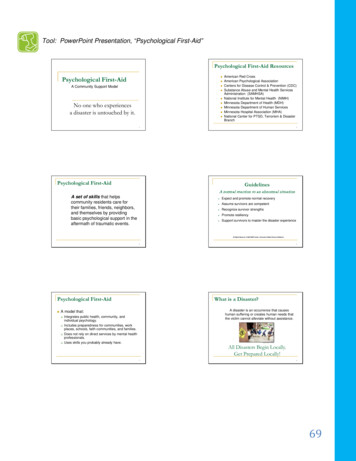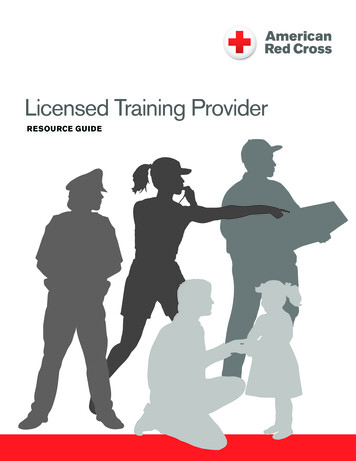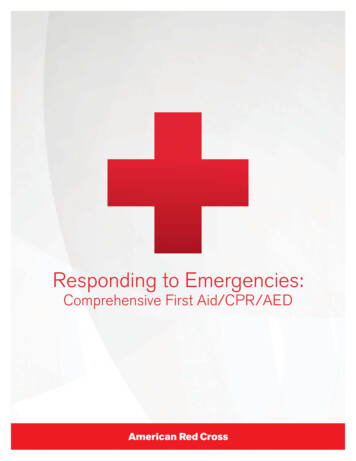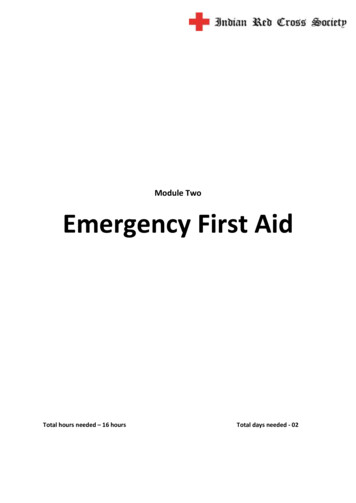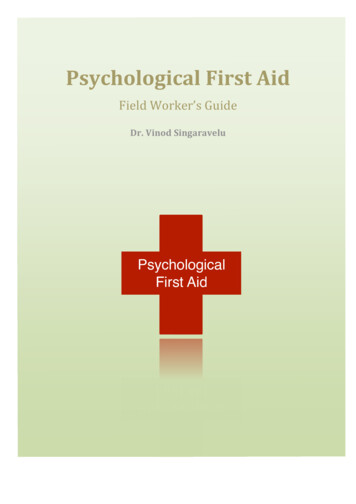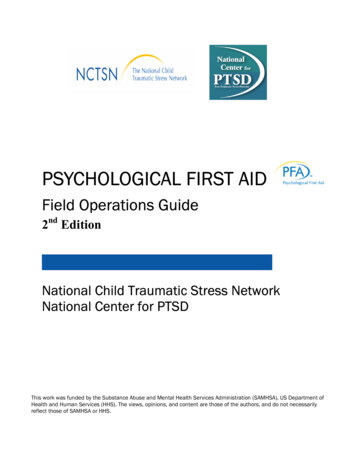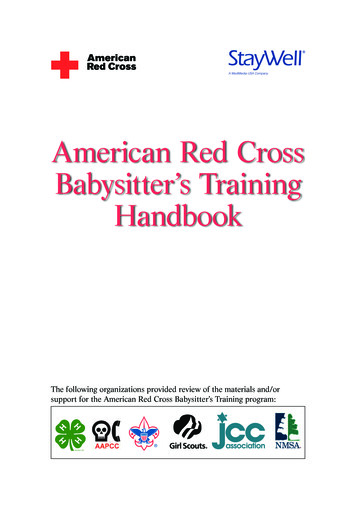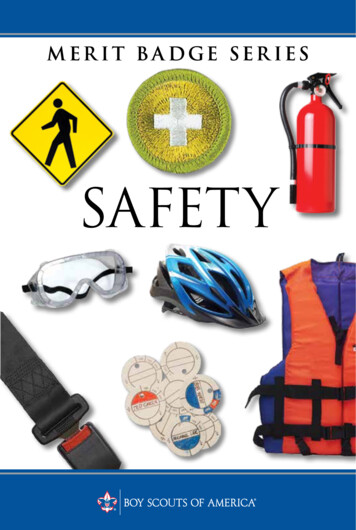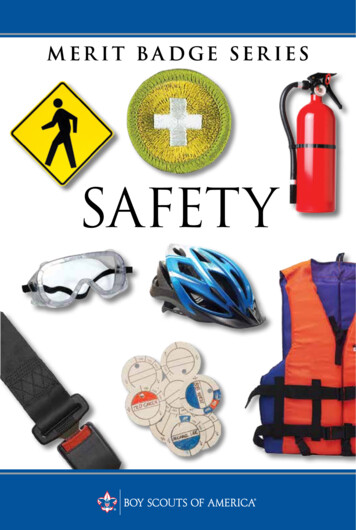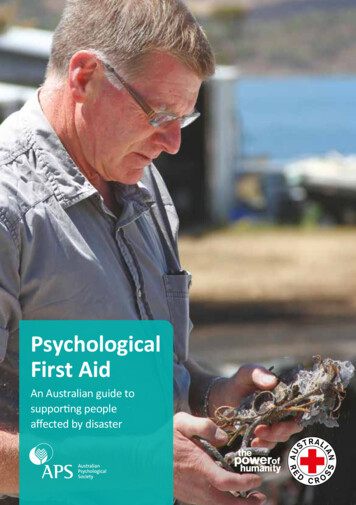
Transcription
PsychologicalFirst AidAn Australian guide tosupporting peopleaffected by disaster
Psychological First AidAn Australian guide to supporting people affected by disasterContentsForeword CopyrightSecond edition published by:Australian Red Cross 2013155 Pelham St, Carlton, Victoria 3053andAustralian Psychological SocietyLevel 11, 257 Collins St, Melbourne, Victoria 3000National Library of AustraliaCataloguing-in-publication data:ISBN: 978-0-909896-00-3Within this resource, the term ‘emergency’ isused and can apply to any form of emergencyincident or disaster. Where the term ‘disaster’ isused, this is interchangeable to ‘emergency’ andconnotations of one term over the other shouldnot be made.All rights reserved. No part of this publicationmay be reproduced, stored in a retrieval system,or transmitted in any form, or by any means,electronic, mechanical, photocopying, recordingor otherwise without the prior written consent ofthe publisher.Cover image: Australian Red Cross/Antony Balmain Australian Red Cross/Allan ReinikkaPhotography copyright: All images are referencedwithin and remain the property of the AustralianRed Cross, stated photographer, or other partiesas noted.2Understanding psychological first aidWhat is psychological first aid?What psychological first aid isn’tWho benefits from psychological first aid?The aim of psychological first aidFive elements of psychological first aidWho delivers psychological first aid?Where is psychological first aid delivered?45679101213Using psychological first aid in the fieldPreparing to provide psychological first aid in the fieldImportant questions to ask before entering an emergency sitePsychological first aid action principlesImportant questions and messages to consider when usingpsychological first aid14151618Adapting psychological first aidFor cultureFor children and young peopleFor people with health conditions or physical or mental disabilities22232426Self care for people working in the fieldSelf careReducing stress282929Useful organisationsReferences and resourcesAcknowledgments32333619
2 Psychological First AidForewordThis psychological first aid guideis for people working in disasterpreparedness, response and recovery. Itprovides an overview of best practice inpsychological first aid following disastersand traumatic events.Each state and territory has plansto deal with the health impacts ofdisasters. Included in these plans arearrangements that cover the mentalhealth impacts of emergencies.There are many types of psychologicalfirst aid and it is increasingly beingused in the post disaster field. Thereis an urgent need for this techniqueto be given an Australian context.Psychological first aid needs to bepackaged in a way that clearly outlinesits aims, components, when it is used,where it can be applied, and whobenefits from its use, who can deliver it.This guide sets out to achieve thisaim in a simple form. It complementswork done by the Disaster Responseand Resilience Research Group atthe University of Western Sydney. DrSally Wooding and Professor BeverleyRaphael have written a chapter onpsychological first aid that provides anAn Australian guide to supporting people affected by disaster 3overview of the field (see reference list).The guide is also used in conjunctionwith psychological first aid trainingdelivered by Australian Red Cross.activities focused more on therebuilding of towns damaged by floods,fire or storms and healing the physicalwounds of those injured.Emergency is the generic term used inAustralia to describe disruptive and/ordestructive events that cause loss oflife, property and livelihoods, injury anddamage to communities.Disaster mental health and theidentification of post-traumatic stressdisorder led to a shift in approaches toemergency management. Responsesduring this period focused onapplying clinical mental health skills inemergency settings, for which they werenever intended.For the individual this may mean theloss of: near or significant loved ones control over one’s own life and future hope and initiative dignity social infrastructure and institutions access to services property and belongings livelihoods place.After an emergency, people often loseconfidence in the norms, networks, andtrust in the society that is supposed toprotect them1. Until the late 1970s, thepsychosocial aspect of emergencies wasoften ignored. Emergency management1 For more information see International Federation of RedCross and Red Crescent Societies 2009.It was then recognised that mostpeople did not develop serious mentalhealth issues after emergencies. Mostpeople recover well with some basicsupport. This led to the development ofpsychological first aid as a primary toolafter an emergency.It has been recognised both in Australiaand internationally that psychosocialsupport in emergencies is best deliveredas a community-based activity, ratherthan within a medical health system2.Providing coordinated psychosocialsupport in emergencies has nowbecome a critical part of preparing for,2 For more information see Inter-Agency Standing Committee2007; International Federation of Red Cross and Red CrescentSocieties 2009; van Ommeran, Saxena & Saraceno 2005.responding to and recovering froman emergency.This guide is also in line with resourcesdetailed in the Psychosocial Support inDisasters portal (www.psid.org.au) andthe World Health Organization, WarTrauma Foundation and World VisionInternational (2011) Psychologicalfirst aid: Guide for field workers.WHO: Geneva.
4 Psychological First AidAn Australian guide to supporting people affected by disaster 5What is psychological first aid?Psychological first aid is a ‘humane,supportive response to a fellowhuman being who is suffering andwho may need support’1.Psychological first aid is an approachto helping people affected by anemergency, disaster or traumatic event.It includes basic principles of support topromote natural recovery. This involveshelping people to feel safe, connected toothers, calm and hopeful, access physical,emotional and social support, and feelable to help themselves2. Psychologicalfirst aid aims to reduce initial distress,meet current needs, promote flexiblecoping and encourage adjustment. Australian Red Cross/Jack TranUnderstandingpsychologicalfirst aidPsychological first aid is useful as the firstthing that you might do with individualsor families following a disaster. It is mostwidely used in the first hours, days andweeks following an event. Psychologicalfirst aid is based on an understandingthat people affected by disasters willexperience a range of early reactions(physical, psychological, emotional,1 The Sphere Project and the Inter-AgencyStanding Committee.2 For more information see Hobfoll et al. 2007.behavioural). These reactions mayinterfere with their ability to cope3.These reactions are normal andunderstandable given people’sexperiences. Recovery may be helped bypsychological first aid.A small part of an affected populationwill require further mental healthsupport to assist recovery. But mostpeople recover well on their own orwith the support of compassionateand caring disaster workers, familyand friends.Psychological first aid is most commonlyused immediately after a disaster.But its use is not limited to this timeperiod. Sometimes the first contactpeople have with psychological first aidcomes months or even years after theemergency. Outreach visits conductedby Red Cross nine months after the 2009Victorian bushfires, for example, werethe first time many people receivedpsychological first aid. Psychologicalfirst aid skills can also be applied topublic inquiries and anniversaries ofemergencies or traumatic events, allof which may take place years afterthe event.3 For more information see Brymer et al. 2006.
6 Psychological First AidPsychological first aid has a long history1.It has become more popular sincethe emergence of research showingthe dangers of critical incident stressdebriefing2. Since 2002, psychologicalfirst aid has been recommended as akey part of the provision of psychosocialsupport following disasters.What psychological firstaid isn’tIt is important to clarify whatpsychological first aid is NOT todifferentiate it from earlier forms ofpost-disaster support, most notablycritical-incident stress debriefing.It is not useful – and may be harmful –to directly encourage disaster survivorsto talk about what happened to themif they do not want to. If a personwants to discuss their experiences,it is useful to provide them withsupport. But this should only be ina way that does not push them todiscuss more than they want3.1 For more information see Drayer, Cameron, Woodward &Glass 1954; Raphael 1977a&b and 1986.2 For more information see National Institute of Mental Health2002; Rose, Bisson & Wessley 2003; Bisson, Brayne, Ochberg& Everly 2007; Bisson & Lewis 2009.3 For more information see Watson et al. 2002;Ruzek et al. 2007; McNally, Bryant, & Ehlers 2003.An Australian guide to supporting people affected by disaster 7Post-emergency settings are not clinicalenvironments and it is inappropriateto conduct a clinical or psychologicalassessment within the setting.It is important to limit contactat this point to simple support,like psychological first aid. Peoplewho display marked signs of risk(e.g. suicidal tendencies)should be referred to formalmental health services.Psychological first aid is: NOT debriefing NOT obtaining details oftraumatic experiences and losses NOT treating NOT labelling or diagnosing NOT counselling NOT something that onlyprofessionals can do NOT something that everybodywho has been affected by anemergency will need.Who benefits frompsychological first aid?The sudden, disruptive nature ofemergencies means that people willbe exposed to uncertainty and stress.People will experience different degreesof distress. Any person in distressshould have access to psychologicalfirst aid, where possible. This includesadults, adolescents and children, aswell as disaster relief workers and firstresponders.How people respond and cope dependson a variety of factors, including theirexperience of the emergency, theirhealth, their personal history and theiravailable supports.Some people may be at more risk ofnegative consequences. These mayinclude those people who: have had previous traumatic experiences have underlying mental illnesses were exposed to events where thehorror element was high thought they were going to die experienced traumatic bereavement have had serious losses of property,livelihoods, or disruption tocommunities and networks.There will also be some situationswhere people have an immediate needfor more care than can be providedby psychological first aid. Thesepeople need to be promptly referredto specialised support. This includespeople who are: seriously injured and needingemergency medical care so distressed that they are unableto perform the basic activities ofdaily life threatening harm to themselvesor others.It is important to remember that noteveryone who experiences an emergencywill have emotional distress or problemsduring or after the crisis. Not everyonewho experiences a crisis will needpsychological first aid. Some protectingfactors include1: good level of functioningsocial supportability to copestrong moral belief systemsreturning to normal life(i.e. reducing disruption).1 For more information see Johns Hopkins School of PublicHealth & International Federation of Red Cross and RedCrescent Societies 2008.
8 Psychological First AidAn Australian guide to supporting people affected by disaster 9The aim of psychological first aidPsychological first aid is humane,caring and compassionate. It addressesemotional and practical needs andconcerns above all else.An important aim of psychologicalfirst aid is to build people’s capacityto recover. Psychological first aidsupports recovery by helping peopleto identify their immediate needs andtheir strengths and abilities to meetthese needs.One of the most important researchfindings is that a person’s beliefin their ability to cope can predicttheir outcome. Australian Red Cross/Dave TaconSome people will needmuch more support thanpsychological first aid.Know your limits and askfor help from others whocan provide medical orother assistance to averta crisis.Typically people who do better aftertrauma are those who are optimistic,positive and feel confident that life andself are predictable, or who displayother hopeful beliefs1.The goals of psychological first aidinclude efforts to: 1 For more information see Carver 1999, Ironson et al. 1997,Solomon 2003.calm peoplereduce distressmake people feel safe and secureidentify and assist with current needsestablish human connectionfacilitate people’s social supporthelp people understand the disasterand its contexthelp people identify their ownstrengths and abilities to copefoster belief in people’s ability to copegive hopeassist with early screening for peopleneeding further or specialised helppromote adaptive functioningget people through the first period ofhigh intensity and uncertaintyset people up to be able to recovernaturally from an eventreduce the risk factors of mentalillness as a result of the event, such aspost traumatic stress disorder.
10 Psychological First AidAn Australian guide to supporting people affected by disaster 11Five elements of psychological first aidThere are five basic elements topsychological first aid that havebeen drawn from research on riskand resilience, field experience andexpert agreement1.The elements of psychological first aidare to promote: safety calm connectedness self-efficacy and group efficacy hope.1. Promote safety Remove from, or reduce exposure to,threat of harm. Help people meet basic needs forfood, water, shelter, financial andmaterial assistance. Help people obtain emergencymedical attention. Provide physical andemotional comfort.1 For more information see Hobfoll et al. 2007, IFRC 2009,SAMHSA 2010, Queensland Health (2008). Provide repeated, simple andaccurate information, in a range ofmethods, on how to get these basicneeds met.2. Promote calm Stabilise people who areoverwhelmed or disoriented. Provide an environment, as far aspractical, removed from stressfulsituations or exposure to sights,sounds and smells of the emergency. Listen to people who wish to sharetheir stories and emotions, withoutforcing them to talk. Remember that there is no right orwrong way to feel. Be friendly and compassionate even ifpeople are being difficult. Offer accurate information aboutthe disaster or trauma and the reliefefforts underway to help survivorsunderstand the situation. Provide information on stressand coping. When they express fear or worry,remind people (if you know) that morehelp and services are on the way.3. Promote connectedness Help people contact friends andloved ones. Keep families together. Keep children with parents or otherclose relatives whenever possible. Help establish contacts with supportpeople (friends, family or communityhelping resources). Respect cultural norms regardinggender, age and family structures. Offer practical help to people toaddress immediate needs andconcerns. Provide information and direct peopleto those services that are available. Link people with available services. Respect cultural norms regardinggender, age, family structures andreligion.4. Promote self efficacy Engage people in meeting theirown needs. Assist with decision making, helpthem to prioritise problems andsolve them.5. Promote hope Convey expectancy that peoplewill recover. Be there/be willing to help. Reassure people that their feelingsare normal.Self efficacy is the beliefthat one’s actions arelikely to lead to positiveoutcomes, and feelingable to help oneself.
12 Psychological First AidAn Australian guide to supporting people affected by disaster 13Who delivers psychological first aid?Psychological first aid should bedelivered by appropriate agencies aspart of state, regional/district or localemergency management plans.This means that responses can beundertaken in a coordinated mannerand that psychosocial support isprovided as a key part of the emergencyresponse. In Australia, this coordinatedresponse could include: health andallied health professionals, teachersand other education professionals,members of the clergy and otherfaith-based organisations, RedCross personal support volunteersand other trained responders fromcommunity organisations, and localgovernment staff.The principles of psychological first aidmean that it can be offered by a widevariety of people in the community– from emergency personnel toneighbours and volunteers – in additionto trained responders.Psychological first aid is a humane,supportive and practical response to aperson who has been exposed to seriousstresses and may need support1. Mostpeople responding to an emergency areable to provide this type of assistance,comfort and support to peoplein distress2.The principles of psychological firstaid are an important grounding for allemergency personnel responding toan emergency. Their primary focus willbe on responding to the emergency.But these people are usually the firstcontact survivors have with the ‘system’.So they have an important role to play inassisting in helping to promote recoveryin safe and effective ways.It is useful to differentiate betweengeneral psychological support and theway all emergency responders providehelp in responsible ways. Responsiblehelping respects the dignity andcapacity of survivors. The primary roleof psychological first aid is to protectand promote the mental health andpsychosocial wellbeing of survivors.1 For more information see Inter-Agency StandingCommittee 2007.2 For more information see World Health Organisation 2010.Where is psychological firstaid delivered?Psychological first aid can be deliveredin diverse settings. Psychological first aidcould be delivered at the scene of theemergency or at places where affectedpeople gather, such as: evacuation centresrecovery centreshospitalshumanitarian assistance centreshomesschoolsbusinessesshopping centresairportstrain stationsmemorial servicescommunity centres.Psychological first aidcan be offered by a widevariety of people in thecommunity.
14 Psychological First AidAn Australian guide to supporting people affected by disaster 15Preparing to providepsychological first aid inthe field1Many emergency situations can bestressful and often require urgentaction. The more that is known aboutthe situation, and the better prepareda person is psychologically, the moreeffective the support will be.Prior to using psychological first aid in thefield people should:Usingpsychologicalfirst aid inthe field Australian Red Cross/Dilini Perera Learn about the crisis event. Learn about available services andsupports. Learn about safety, access andsecurity concerns. Consider their physical and mentalpreparedness.1 World Health Organization, War Trauma Foundation andWorld Vision International (2011). Psychological first aid:Guide for field workers. WHO: Geneva.
16 Psychological First AidAn Australian guide to supporting people affected by disaster 17Important questions to ask before entering an emergency siteThe emergency event What happened? When and where did it take place? How many people are likely to beaffected and who are they? How long did it go on for/will goon for?Safety and security concernsAvailable services and supports Who are the relevant authoritiesmanaging the crisis? Who is providing for basic needslike emergency first aid, food, water,material assistance, shelter? Where and how can people accessthese services? Who else is helping? Are communitymembers involved in responding? Is the Register.Find.Reunite. serviceactive to help families reunite? Are there areas to avoid enteringbecause they are not secure (forexample, obvious physical dangers)or because you are not allowed tobe there? Is the crisis event over or continuing,such as aftershocks from anearthquake, or an unfolding floodevent or high bushfire danger period?Physical and mental preparedness Do you have everything you mightneed to be away from home/office(phone, charger, drink bottle, etc)? Have you let family members/friendsknow what you are doing and howlong for? Have you made arrangements forchildren, people you are caring forand pets? Do you feel emotionally ready toprovide psychological first aid? Australian Red Cross/Dilini Perera What dangers may be in theenvironment, such as debris ordamaged infrastructure?
18 Psychological First AidAn Australian guide to supporting people affected by disaster 19Psychological first aid action principles1The World Health Organization (WHO) has developed a framework consisting ofthree action principles to assist in the delivery of psychological first aid.These principles provide guidance for how to view and safely enter an emergencysituation (LOOK) in order to understand the needs of affected people (LISTEN) andlink them with the information and practical support they need (LINK).PrinciplesLookActions Check for safety. Check for people with obvious urgent basic needs. Check for people with serious distress reactions.Listen Approach people who may need support. Ask about people’s needs and concerns. Listen to people and help them to feel calm.Link Help people address basic needs and access services.Help people cope with problems.Give information.Connect people with loved ones and social support.1 World Health Organization, War Trauma Foundation and World Vision International (2011). Psychological first aid:Guide for field workers. WHO: Geneva.Important questions and messages to consider when usingpsychological first aidLookCheck for safety What dangers can you observe, e.g. damaged road, unstable buildings, fire,flooding etc? Ask if you can be there safely without harming yourself or others If you are not certain that the area is safe, then DO NOT GO!Check for people with obvious urgent basic needs Does anyone need emergency first aid? Do people need urgent protection (e.g. clothing)? Are there any people who might need special attention? Know your role and try to obtain help for people who need specialassistance or who have obvious urgent basic needsCheck for people with serious distress reactions Are there people who are extremely upset, immobile, not responding toothers, disturbing others, or in shock? Where and who are the most distressed people? Consider who may benefit from psychological first aid and howyou can best help.
20 Psychological First AidAn Australian guide to supporting people affected by disaster 21ListenLinkApproach people who may need support Approach people respectfully and according to cultural norms Introduce yourself by name and organisation Ask if you can provide help If possible, find a quiet and safe place to talk Help the person feel comfortableHelp people address basic needs and access services For example, food, water, shelter, material needs Learn what specific needs people have and try to link them toavailable assistance Do not make promises you cannot keepAsk about the people’s needs and concerns Address any obvious needs. For example, if a person’s clothing is torn orthey need a blanket Always ask for people’s needs and concerns Do not assume you know Find out what is most important to them at this moment Help them work out what their priorities areListen to people and help them to feel calm Stay close to the person Do not pressure the person to talk Listen in case they want to talk about what happened If they are very distressed help them to feel calm and try tomake sure they are not aloneHelp people cope with problems Help identify their most urgent practical needs and assist with prioritising Help the person identify support people Give practical suggestions for people to meet their own needs (e.g. how toregister with Centrelink etc)Give information Find out where to get information and updates Try to get as much information as you can before approaching peoplewith support Keep updated Only say what you knowConnect people with loved ones and social support Keep families together and children with their parents Help people to contact friends or relatives. If prayer or religious practice is important people maybenefit from being linked with their spiritual base
22 Psychological First AidAn Australian guide to supporting people affected by disaster 23For cultureCulture can refer to the behavioursand beliefs of a person’s social, ethnicand/or age group. Culture determineshow we relate to people, and what isright and not right to say and do. It isimportant to adapt our communicationswith people as a way of being respectfulto their choice of culture.Consider the following questions:Dress Do helpers need to dress a certainway to be respectful? Body covering?Colours? Will people affected be in need ofcertain clothing items to keep theirdignity and customs? Australian Red Cross/Rodney DekkerAdaptingpsychologicalfirst aidLanguage What is the customary way ofgreeting people in this culture? What language do they speak? Are there formal and informal formsof address?Gender, age and power Should affected women only beapproached by women helpers? Who may be approached(in other words, the head of thefamily or community)?Touching and behaviour What are the usual customs aroundtouching people? Is it all right to hold someone’s handor touch their shoulder? Are there special things to considerin terms of behaviour around theelderly, children, women or others? Is eye contact appropriate?Beliefs and religion Who are the different ethnicand religious groups among theaffected people? What beliefs or practices areimportant to the people affected? How might they understand orexplain what has happened?
24 Psychological First AidThe following points are importantwhen using psychological first aid withchildren and young people1.Keep together with loved ones When unaccompanied, link themwith a trustworthy child protectionnetwork or agency. Do not leave thechild unattended. Be wary of offers of help withlooking after children fromunauthorised strangers. If no child protection agency isavailable, take steps to find theircaregivers or to contact other familywho can care for them.Keep safe Protect them from being exposed toany gruesome scenes, like injuredpeople or terrible destruction. Protect them from hearing upsettingstories about the event. Protect them from the media or frompeople who want to interview themwho are not part of the emergencyresponse.1 World Health Organization, War Trauma Foundation andWorld Vision International (2011). Psychological first aid:Guide for field workers. WHO: Geneva.Listen, talk and play Be calm, talk softly and be kind. Introduce yourself by name and letthem know you are there to help. Find out their name, where they arefrom, and any information you can inorder to help find their caregivers andother family members. Listen to children’s views ontheir situation. Try to talk with them on their eyelevel, and use words and explanationsthey can understand. Support the caregivers in taking careof their own children. If passing time with children, tryto involve them in play activitiesor simple conversation about theirinterests, according to their age. Australian Red Cross/Antony BalmainFor children and young peopleAn Australian guide to supporting people affected by disaster 25
26 Psychological First AidAn Australian guide to supporting people affected by disaster 27The following points are importantwhen assisting people who mayhave health conditions or physical ormental disabilities. Help people get to a safe space. Ask people if they have any healthconditions, or if they regularly takemedication for a health problem. Try to help people get theirmedication or access medicalservices, when available. Stay with the person or try to makesure they have someone to help themif you need to leave. Consider linkingthe person with relevant support toassist them in the longer term1. People with a disability, particularlya cognitive disability, may rely uponrigid routines in their lives. Disruptionto these routines may make themhighly anxious.1 World Health Organization, War Trauma Foundation andWorld Vision International (2011). Psychological first aid:Guide for field workers. WHO: Geneva. Face and speak directly to the personrather than through the companion,attendant or sign-languageinterpreter who may also be present.For example do not say “tell her.” or“can he.” Never speak about the person as ifthey are invisible, cannot understandwhat is being said or cannot speakfor themselves. If a person requiresan interpreter or carer to assist themin conversation, make sure there isenough time for the person to absorbinformation and respond on their own. Allow for short breaks if a personneeds extra time to processinformation. Offer several different options forfurther contact. Some people mayfeel more comfortable with face toface interaction while others mayprefer the telephone or email2.2 Australian Emergency Management Institute, CommunityRecovery Handbook 2Remember that peopleare resilient. All peoplehave the ability to cope.Help people use familiarcoping strategies andsupports. Australian Red Cross/Bradley KanarisFor people with health conditions or physical or mental disabilities
28 Psychological First AidAn Australian guide to supporting people affected by disaster 29Self careReducing stressThe delivery of psychological firstaid following an emergency can bevery rewarding for people involved inthe emergency response. However,it can also be very challenging andstressful. It is not uncommon for peopleto feel stressed, distressed, tired,overwhelmed, troubled, or frustrated inthe course of their work.Stress wil
Psychological first aid is most commonly used immediately after a disaster. But its use is not limited to this time period. Sometimes the first contact people have with psychological first aid comes months or even years after the emergency. Outreach visits conducted by Red Cross nine mon

